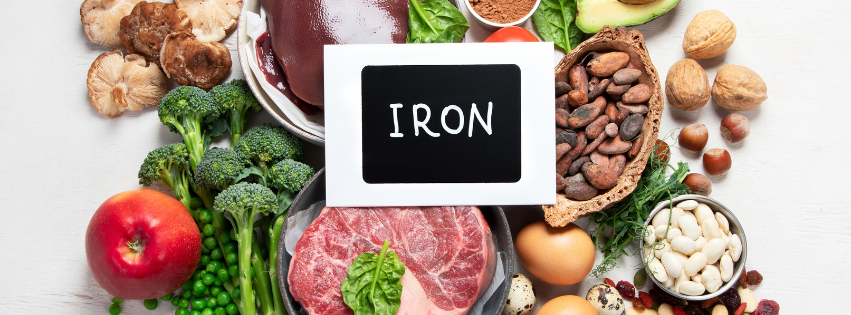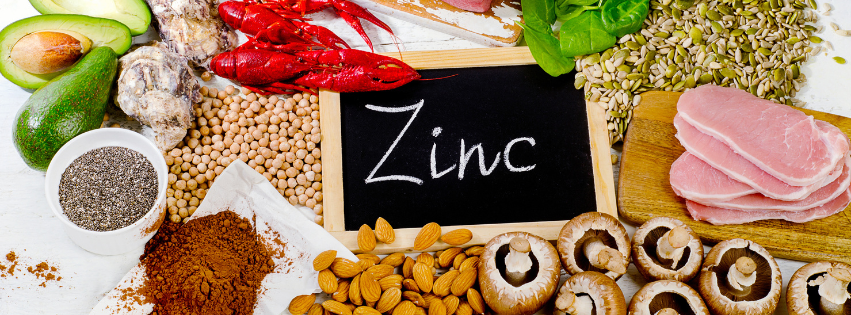4 Key Minerals You Might Be Deficient In – and How to Replenish Them
- Paula Grubb Nutrition

- Aug 3
- 7 min read
Updated: Aug 6
Mineral deficiencies are more common than you might think—especially when it comes to magnesium, iron, zinc, and calcium.
These four essential minerals are small in size, but they have a huge impact on how your body functions. From supporting your energy and mood to regulating hormones, digestion, immunity, and bone strength—your body depends on a steady supply of these nutrients to thrive.
Yet many people aren’t getting enough. Thanks to modern diets, chronic stress, poor digestion, certain medications, and even soil depletion, mineral deficiencies are widespread—and often overlooked.
According to global research:
Up to 50% of people may be low in magnesium, often without realising it.
Iron deficiency is the most common nutritional deficiency worldwide, especially among women.
Zinc levels tend to drop under chronic stress or in people eating plant-based diets.
Calcium intake has declined in recent decades, partly due to dairy avoidance and dietary shifts.
The signs of deficiency can be subtle—like low energy, sleep issues, mood swings, or brittle nails—so they’re easy to miss or misattribute. But left unaddressed, these gaps can quietly affect everything from mental clarity to immune resilience.
In this article, I’ll walk you through the 4 key mineral deficiencies I commonly see in clinic, how they show up in the body, and most importantly—how you can start replenishing them naturally through food and lifestyle.

1. Magnesium Deficiency
Magnesium is a powerhouse mineral involved in over 300 enzymatic reactions in the body. It helps regulate muscle function, nerve transmission, energy production, and bone health. Magnesium also plays a key role in activating vitamin D, a hormone critical for calcium absorption and bone health.
How to know if you are low in Magnesium:
In addition to the common symptoms like muscle cramps and fatigue, magnesium deficiency can also cause:
Heart arrhythmias: Magnesium helps regulate the electrical impulses in your heart, and a deficiency can lead to irregular heartbeats.
Increased stress response: Low magnesium levels are linked with higher stress hormones, leading to feelings of anxiety or irritability.
Constipation: Magnesium helps relax muscles in the digestive tract, and insufficient levels can slow down the bowel, leading to constipation.
Nausea and vomiting: Severe magnesium deficiency can lead to digestive disturbances, often in conjunction with other symptoms.
Sleep disturbances: Magnesium plays a role in regulating neurotransmitters that promote relaxation and sleep; deficiency may contribute to insomnia or poor sleep quality.
Headaches or migraines: Low magnesium is linked to an increased frequency and severity of headaches and migraines in some individuals.
Numbness or tingling: Magnesium deficiency can cause neurological symptoms such as pins and needles or numbness, especially in the extremities.
Personality changes or mood disorders: In more severe cases, magnesium deficiency has been associated with symptoms such as depression, confusion, or apathy.
What to Eat for Magnesium:
Leafy Greens (spinach, Swiss chard, kale): Magnesium-rich leafy greens are a great way to increase your intake.
Nuts and Seeds (almonds, sunflower seeds, cashews): These are convenient and nutrient-dense snacks that provide a good dose of magnesium.
Legumes (black beans, lentils): Beans and lentils are not only rich in magnesium but also fiber, helping with digestion.
Whole Grains (quinoa, oats, brown rice): Whole grains provide magnesium while supporting overall digestive health.
Dark Chocolate (70% cocoa or more): Dark chocolate is a delicious source of magnesium and also contains antioxidants, which benefit heart health.
Additional Tips:
Magnesium is best absorbed when taken with foods containing fiber. Pair your magnesium-rich foods with fiber-rich vegetables or fruits for enhanced absorption.
Stress can deplete magnesium levels, so finding ways to reduce stress (yoga, meditation, walking) can help maintain adequate magnesium levels.

2. Iron Deficiency
Iron is essential for producing hemoglobin in red blood cells, which allows them to carry oxygen throughout the body. Iron deficiency is common, particularly among women of reproductive age, vegetarians, and those with heavy menstrual cycles or gastrointestinal disorders that impair absorption.
How to know if you are low in Iron:
Iron deficiency can affect your energy levels and overall health:
Paleness of skin: Without sufficient iron, your body can’t produce enough hemoglobin, which gives red blood cells their color.
Fatigue: The lack of oxygen being transported to your muscles and tissues leads to feelings of fatigue and weakness.
Dizziness and shortness of breath: As your body struggles to carry oxygen, even light physical activities can leave you winded.
Cold extremities: Iron is critical for maintaining proper circulation, so a deficiency can lead to cold hands and feet.
Restless legs syndrome: Low iron levels can cause involuntary leg movements, especially at night.
Brittle nails and hair thinning: Iron plays a role in healthy hair growth and nail strength, so deficiency may cause nails to become fragile and hair to thin.
Pica: Some people develop cravings for non-food items such as ice, dirt, or starch when iron is low.
Signs of internal bleeding: Unexplained anemia or iron loss can sometimes be due to bleeding in the digestive tract. Look out for black or tarry stools, blood in vomit, or other unusual bleeding, which should be evaluated by a healthcare professional.
What to Eat for Iron:
Red Meat (beef, lamb): Red meat is one of the richest sources of heme iron, which is more easily absorbed by the body compared to plant-based iron.
Poultry (chicken, turkey): Chicken and turkey offer a good amount of bioavailable iron without the higher fat content of red meat.
Leafy Greens (spinach, kale): These plant-based foods provide non-heme iron, but it’s not as easily absorbed as heme iron from animal sources.
Legumes (lentils, beans, chickpeas): These are great plant-based sources of iron, though you should pair them with vitamin C for better absorption.
Fortified Cereals: Many breakfast cereals are fortified with iron, making them an easy way to increase iron intake.
Additional Tips:
Vitamin C (from citrus fruits, tomatoes, bell peppers) enhances non-heme iron absorption, so pair plant-based iron sources with vitamin C-rich foods.
Iron supplements should only be taken under medical supervision as excess iron can be harmful.

3. Zinc Deficiency
Zinc is a trace mineral essential for immune function, wound healing, DNA synthesis, and protein metabolism. It also plays a key role in maintaining healthy skin, hair, and nails.
How to know if you are low in Zinc:
Zinc deficiency can impact both physical health and immune function:
Weakened immune system: Zinc is crucial for immune cell production. Deficiency can result in a weakened immune system, increasing the risk of infections.
Hair loss: Zinc is vital for hair follicle function, and a deficiency can result in thinning or loss of hair.
Poor wound healing: Zinc plays a key role in collagen formation, which is necessary for wound healing. Low zinc levels can delay recovery from injuries or cuts.
Skin issues: Zinc is important for maintaining skin health. Deficiency may lead to conditions like acne, eczema, or rashes.
Altered taste and smell: Zinc is involved in the functioning of taste and smell receptors, and a deficiency can make food taste bland or cause a metallic taste.
Gut lining integrity: Zinc is essential for maintaining the health of the intestinal lining. Deficiency may contribute to increased intestinal permeability (leaky gut), which can impact digestion and immune regulation.
Reduced fertility in men: Zinc plays a role in sperm production and quality. Low levels have been linked to decreased sperm count and motility.
What to Eat for Zinc:
Oysters and shellfish: Oysters are one of the richest sources of zinc. If you're not a fan, other shellfish like crab and lobster also provide significant amounts.
Red Meat (beef, lamb): A rich source of bioavailable zinc.
Poultry (chicken, turkey): Like red meat, poultry is an excellent source of zinc.
Nuts and Seeds (cashews, pumpkin seeds): Great for snacking, nuts and seeds are also rich in healthy fats and fiber.
Legumes (chickpeas, lentils, beans): These are good plant-based sources of zinc.
Whole Grains (quinoa, oats): Zinc from grains is not as readily absorbed, but they still contribute to your overall intake.
Additional Tips:
Zinc is absorbed more efficiently from animal sources than plant-based ones. If you are vegetarian or vegan, consider zinc supplementation or consuming zinc-rich foods with fermented foods (like miso or kimchi), which can enhance absorption.
If you're taking zinc supplements, be mindful of not overdoing it, as high doses can interfere with the absorption of other minerals like copper.
Take zinc supplements away from iron and calcium (ideally by 2 hours), as these minerals can compete for absorption and reduce zinc’s effectiveness.

4. Calcium Deficiency
Calcium is the most abundant mineral in the body, primarily stored in bones and teeth. Beyond bone health, it plays a role in muscle function, blood clotting, nerve transmission, and heart function.
How to know if you are low in Calcium:
A deficiency in calcium can have serious consequences:
Bone issues: The most noticeable symptom of calcium deficiency is brittle bones or a higher risk of fractures.
Muscle cramps or spasms: Calcium is necessary for muscle contraction, and without enough, you may experience cramps or spasms.
Numbness and tingling: Low calcium levels can affect nerve function, leading to sensations of tingling or numbness, often in the fingers or toes.
Fatigue and weakness: Insufficient calcium can leave you feeling weak and fatigued due to its role in energy metabolism and muscle function.
Abnormal heart rhythms: In severe cases, a calcium deficiency can affect your heart's ability to maintain a steady rhythm, potentially causing palpitations.
What to Eat for Calcium:
Dairy Products (milk, cheese, yogurt): These are the most common sources of bioavailable calcium.
Leafy Greens (kale, collard greens, bok choy): These calcium-rich vegetables are also high in fiber and antioxidants, making them a great addition to your diet.
Fortified Plant-Based Milks (almond, soy, oat milk): Many plant-based milks are fortified with calcium to provide an alternative to dairy.
Tofu (calcium-set): When tofu is set with calcium salts, it becomes an excellent source of the mineral.
Fish (sardines, salmon with bones): These provide calcium in an easily absorbable form, thanks to the bones.
Seeds (chia, sesame seeds): These are not only rich in calcium but also contain healthy fats and fiber.
Additional Tips:
Vitamin D is essential for calcium absorption, so ensure you're getting enough sunlight or foods like fortified dairy products, egg yolks, and fatty fish to support calcium utilization.
Vitamin K2 works alongside vitamin D to help direct calcium into your bones and teeth where it belongs—rather than into soft tissues or arteries. You can find K2 in foods like aged cheeses, egg yolks, liver, and natto.
Regular weight-bearing exercises, such as walking, jogging, or resistance training, can help maintain bone density and prevent calcium loss.
Final Thoughts
By paying attention to the signs of these deficiencies and incorporating mineral-rich foods into your diet, you can support your overall health and prevent potential complications. While food should always be your first source of minerals, sometimes supplementation may be necessary, especially if you're dealing with a specific health condition or a restricted diet.
Not sure if you’re deficient?
I offer nutritional assessments and blood test reviews to help uncover what your body might be missing.






.png)

